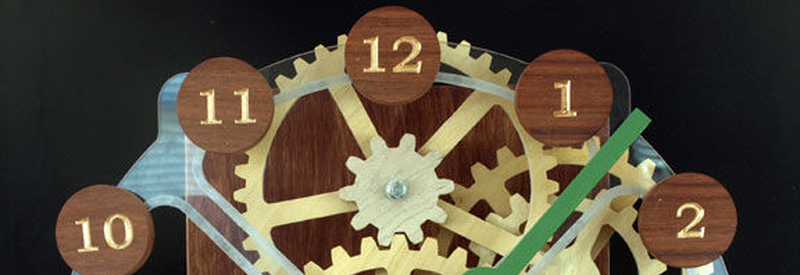[Rjeuch] liked a wooden clock he saw on the Internet, but the gears were produced with a proprietary software tool. So he built his own version. Unlike the original, however, he chose to use a stepper motor to drive the hands.
The clock’s gears aren’t just for show, and the post does a good job explaining how the gears work, how you might customize them, and how they fit together. The clock’s electronics rely on an Arduino.
The issue with an Arduino, of course, is that the time base isn’t always good enough to keep time over long periods. To fix that problem [Rjeuch] used a ChronoDot which is a real-time clock that uses temperature compensation and claims to be accurate to a minute a year.
Of course, no plan goes off without a hitch. Owing to bad stepper mode specs, the original version of the clock was gaining time overnight. Although the stepper claimed to have a 1:64 reduction gear, the actual ratio wasn’t that precise ([Rjeuch] estimates it as 1:63.876. The steps he took to fix this are worth a read.
You can see a video of the clock below. We’ve seen lots of other clocks, of course. Some of them even make this one looks simple.
















private video? well that’s just peachy.
Yeah right? And after we edit/schedule it too. I’ll pull it.
The main (Instructable) link still works, though.
Since that video is dead, here’s another “gear clock”
https://www.youtube.com/watch?v=06lKlQFfdNE
The pcb and stepper motor for this clock can be found here!
http://www.bitwizard.nl/shop/index.php?route=product/product&product_id=162
ChronoDot is fancy name for a DS3231 module where you pay $17 just for a name, same module without that name is less than a $1.
Can’t view the video, but is he sure the error is in the stepper motor and not in his gears? I know which sounds more likely.
Nope, it seems that gear reduction of the motor is not exactly as specified. However, he invested some serious time and hardware into correcting errors made by probably world’s worst stepper motor (for this purpose). Most steppers I’ve seen have “degrees per step” specified and those are ideal for this purpose, choose one with 3 degrees per step or 6 degrees per step, and the work is done. His motor have 512 steps per circle and 1:63 dot something reduction gear. Completely oposite of what you need for making analog clock.
Now a challenge; how would people here go about designing a 1:63.876 reduction gear? Having a 250 teeth and a 15696 teeth gear does not seem plausible.
Just do Bresenham in software. If he’s got a stepper, presumably there’s a micro driving it.
You’re one of the first people to call this Bresenham that I come across. I’ve been doing this since the early 1990ies….. (in two ways: calling it Bresenham, and implementing it in hardware).
It’s more likely that the mechanism manages to skip steps due to some unbalanced mass.
It runs fast because of the combined inertia of the motor and the gear mechanism forward-driving it. When all the forces align to keep the motor spinning forwards, it doesn’t necessarily stop at every tick, instead stepping one or two too many, especially if he’s putting the absolute minimum or absoutely no holding current to it.